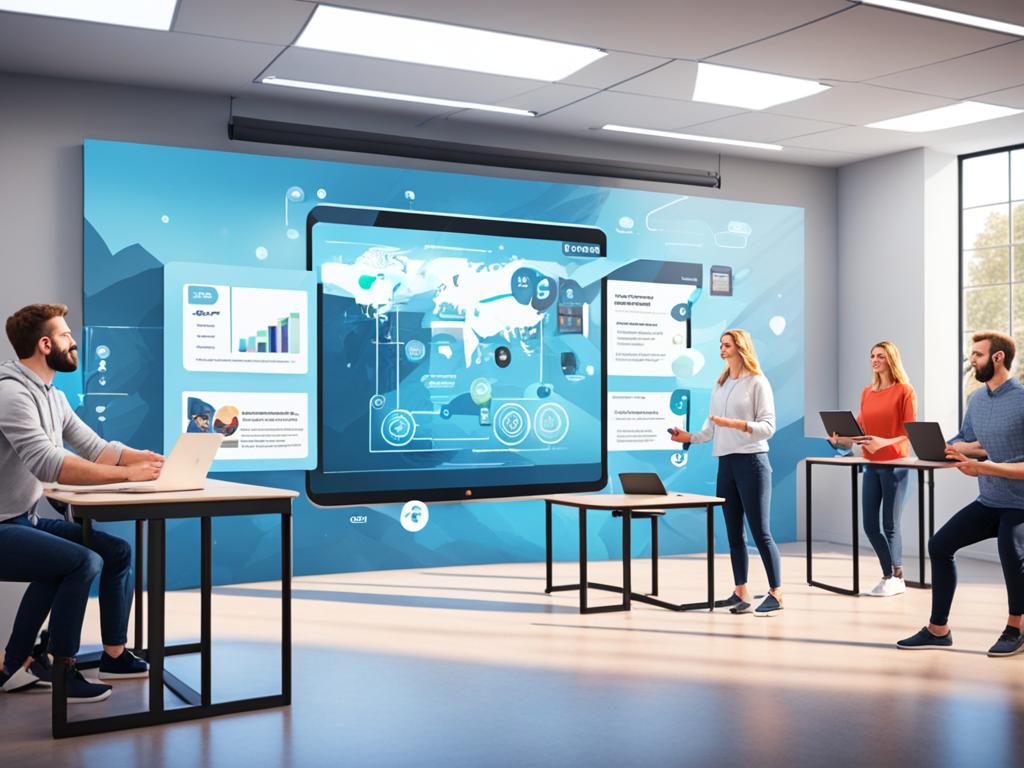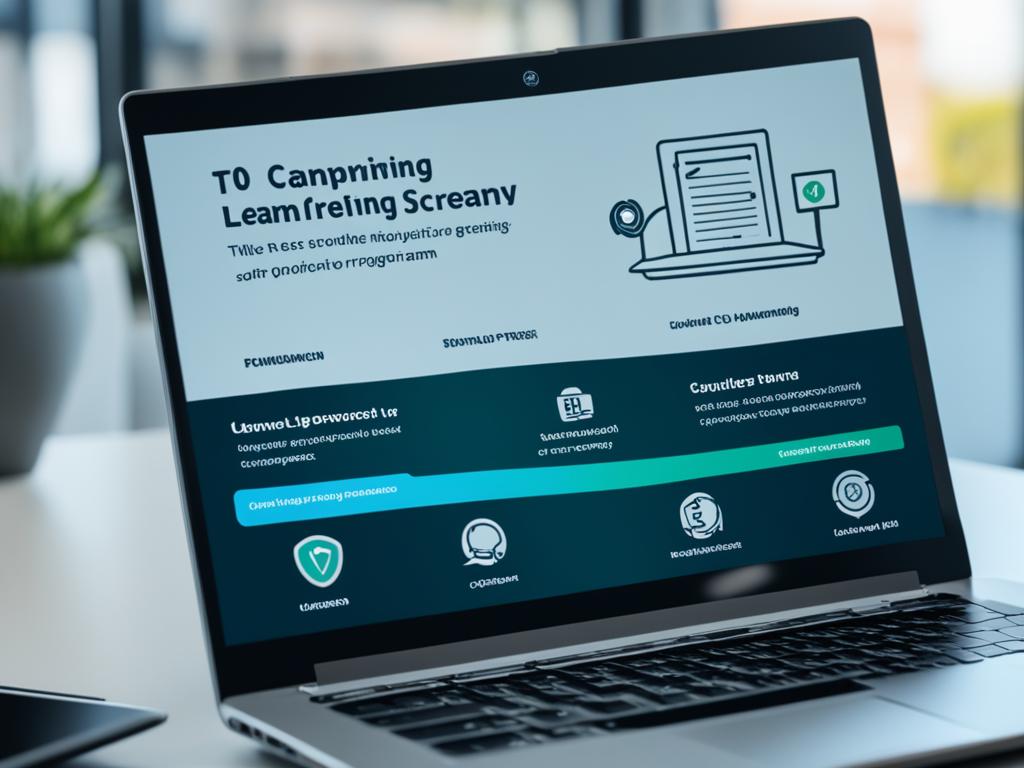Online education has become a key player during the COVID-19 pandemic. It offers a wealth of enriching learning experiences in the digital world.1 Universities and colleges quickly turned to remote learning. There’s been a big boom in online students. Also, huge investments have gone into making online education top-notch. This article will look at why having teachers there matters, the community of inquiry model, and how to keep students engaged in online classes for high-quality programs.
Key Takeaways
- Explore the importance of faculty presence in online classes for meaningful learning experiences.
- Understand the community of inquiry framework and its role in enhancing social, cognitive, and teaching presence.
- Discover engaging strategies, such as interactive tools and collaborative activities, to captivate learners in the virtual classroom.
- Recognize the significance of addressing mental health and well-being in the online learning environment.
- Prepare for the post-COVID educational landscape by embracing blended learning models and prioritizing faculty development.
The Rise of Online Education During the COVID-19 Pandemic
The COVID-19 pandemic made teachers, school staff, and leaders rethink how to teach and learn. Schools around the globe quickly moved their courses online. This was done to keep students safe from the virus and keep learning going. Because of this change, about 1.6 billion students in over 150 countries had to switch to online learning.
In 2020, there was a huge jump in the number of students who only took classes online. This was almost 93% higher than the year before. People predict that by 2025, money spent on online education will reach $350 billion. The pandemic has pushed schools to use more digital tools and technology.
Global Shift to Remote Learning
Before the pandemic, nearly a third of college classes were online.2 When COVID-19 hit, over a billion students worldwide had to leave their classrooms. This pushed schools to move to online teaching fast. They saw more students joining online classes and put more money into tech for learning.3
Surge in Online Enrollment and Investment
In 2019, only around one-third of students tried a class online.3 But in 2020, almost all education went online and student numbers almost doubled. Money spent on online learning is also predicted to increase a lot. The pandemic has made schools use more tech for learning and create more digital class materials.3
This quick change has also changed how teachers teach and how students learn. About 70% of teachers say they’ve changed their teaching style because of this. Almost half of them think teaching will look very different after the pandemic. They are also learning to use online tools better.
Students have also had to change a lot. They are learning to manage their learning more on their own. To make online classes better, teachers need to be more involved, and there should be online help and clear communication. But, stress and mental health issues from the pandemic can still affect how well students do in school.
The pandemic has pushed us all to use online learning more. It has brought more students to online classes and forced us to use more technology in education. Schools need to make sure online classes are good for all types of students. This kind of learning is more needed than ever now.
Importance of Faculty Presence in Online Classes
We are starting to study how students feel about online learning and what makes them happy. But, we don’t know enough about why teachers need to be visible online. They must find new ways to teach, making sure students are involved and feel connected. This helps make learning online better and more meaningful.4
Building Social, Cognitive, and Teaching Presence
The CoI model helps show the teachers how they can be more present online. It talks about how to manage the class, make sure students understand, and teaching directly. By working on these areas, teachers can improve the online class experience.4
Fostering Meaningful Learning Experiences
There are many tricks to make teachers more present online. These include sending welcome notes, talking about course topics, having deep online talks, giving good feedback, helping those who are struggling, and linking lessons to the real world. This makes a big difference for students, helping them do well in online and face-to-face classes. But, online teaching has its challenges, like not meeting in person. It relies a lot on talking without seeing each other, and not all tools help us feel close. Still, many tech tools can help teachers be more there for their students online, making learning more fun and successful.4

The Community of Inquiry Framework
The community of inquiry (COI) framework is a detailed way to increase teacher presence in online classes.5 It combines social, cognitive, and teaching presence to make online learning better for students.5 In 1999, Garrison and others made the COI model to help plan online and part-online courses.5
Enhancing Social Presence
Social presence means making a friendly, team-like space.6 Zoom and Google Meet help a lot with this.6 Starting a “getting to know you” discussion in the first week can make everyone feel welcome and included.7 Also, sharing short videos can boost how much students talk and learn from each other.7
Promoting Cognitive Presence
Cognitive presence aims to promote deep thinking and complex learning.6 It’s about starting discussions that really get people talking and understanding together.6 Make sure the activities in your course match what students are supposed to learn.7 Activities like discussion forums are great for getting students to think deeply and reflect, which makes courses better.7
Cultivating Teaching Presence
Teaching presence is how well teachers design and run online classes.6 It’s set up even before students join the course.6 Clearly laying out how you grade work makes it easier for students to do well.7 Tools like Loom and Hippo Video can help give helpful video lessons and feedback.6
Garrison and his team (2010) showed that mixing social, cognitive, and teaching presence helps make a good online learning space where everyone learns a lot.5 The Community of Inquiry Framework has been getting better for 20 years to make online learning great.6
Engaging Learners in the Virtual Classroom
Educators are finding new ways to make online learning more interesting. They use fun tools and multimedia. They also encourage students to work together.
Interactive Tools and Technologies
Teachers use many cool tools to get students involved. These include things like discussion boards, video calls, and even games.8 These methods make learning fun and help students remember more. This is why online learning is becoming popular even in elementary and high schools.8 If educators want to learn more about teaching online, they can take a course at the University of Phoenix. This course is called Foundations in Virtual Teaching.8
Multimedia Instructional Materials
Using videos, animations, and simulations can really boost learning.8 These tools work well for different types of learners. They also make learning more exciting and interactive.8 Learning online means you can study from anywhere. You just need the internet for your classes, videos, and live lectures.8
Collaborative Learning Activities
Working on projects together helps students share ideas. It also makes them feel like part of a team.9 This kind of work improves social skills. It makes up for not being able to talk face-to-face, which is hard for many online learners.10
By mixing interactive tools, fun media, and teamwork, teachers can spark students’ interest. They can create a great online learning space.

Quality Online Education
Delivering top-notch online education needs a blend of high-tech tools and smart teaching methods.11 Today, online programs are a go-to choice for furthering education from a distance,11 making it key for schools to offer strong learning platforms and lots of digital resources for their students. These efforts are vital for student success.11 Learning can happen whenever and wherever through online classes,11 and students can join the Virtual Classroom at any time.11
Teachers are also crucial in making courses interesting and useful for everyone.11 With online learning, students and teachers can have lively discussions,11 letting students take more control of how they learn.11 Yet, online students might feel a bit hidden,11 and some might miss out if they lack the right technology, especially those in rural and less wealthy areas.11
Having good computer skills is a must for online studies, and hiccups in technology can shake up the learning.11 This style also fits well for older, independent students but might not be the best for those who need more guidance, like some young students.11
12 Online courses are a big thing for teachers worldwide to learn and improve,12 offering benefits in both developed and developing nations.12 With classes available on mobile devices, even the most remote teachers can take part, helping to bridge educational gaps.12 In addition, it’s a cost-effective way to offer training, which is good news for groups like women and the disabled, often held back by cultural or travel barriers.12
12 Still, the lack of consistent quality in online courses is a real issue without solid evaluations, and12 there isn’t enough data showing the lasting benefits for teachers.12 Keeping a close eye on quality by checking if they meet set standards is key to trust in online education,12 and being part of a recognized online course can boost future job and study opportunities.12
12 Ongoing checks and strict assessments are vital for online education’s success, and knowledgeable teachers are a must for students to do well.12 It’s important that programs properly train their online instructors,12 and by ensuring they meet quality standards, we can enhance the entire learning experience.12
Addressing Mental Health and Well-being
The COVID-19 pandemic hit students’ mental health hard. It made problems like anxiety, stress, and feeling alone worse.13 Many studies confirm that college students often face mental health troubles. They can suffer from long periods of feeling sad, getting eating issues, and feeling worse.13 It’s crucial for schools to step up. They should offer mental health help and support students online.
Supporting Students’ Mental Health
Instructors can do a lot. They can make students feel like they’re part of a team, give them counseling, and share strategies to keep their mental health in check.13 Some signs might be physical, like not eating well, not sleeping, or always tired. Or they could be emotional, like feeling very down or nervous all the time.13 Feeling bad might even lead to hurting themselves or, in the worst cases, thinking of ending their lives. Ignoring mental health could cause problems that stick around for a long time.13
Creating a Supportive Online Environment
13 Students might find it hard to concentrate, have little motivation, or not join activities much. They could feel very alone and not think much about themselves.13 Doing classwork and projects online can make social worries a bit less. It feels safer learning from home, especially for those students already dealing with mental health issues.13 Online classes also mean less stress from getting to and from school. This gives students more time and energy for other things. It helps them keep their school and personal life in balance.13 The internet is packed with lessons and help for students. It can lower the pressure of schoolwork and make students feel more in control of their studies.13
Let me give you some info about National University. It has over 41,000 students and 3,300 staff, all working online.14 The students are from all walks of life, like working adults, parents, and military folks. About one-third have military backgrounds, including veterans and their families.14 The university helps students with very busy lives. This includes those currently serving, veterans, and parents.14 To take care of their mental health, they team up with TimelyCare. This gives students an easy way to reach out to therapists and counselors 24/7. It’s great because these professionals can talk to students in many different languages, making it easier for everyone to get help.14

Preparing for the Post-COVID Educational Landscape
Educational settings are getting ready for a new chapter. They are looking into blended learning models. These models mix online and in-person classes for a complete learning experience. It allows for more flexibility too.15 Reports show that more schools are putting effort into online learning. They are using more tech to meet what students want. This trend started in 2020 and continued into 2021.15
Blended Learning Models
Blended learning combines online and traditional methods. It has become more important after COVID-19. This way, schools can use the benefits of online learning like being flexible. Yet, they can still have the important face-to-face talks and activities.16 Schools like Crossroads FLEX in Cary, N.C., allow students to blend school with other activities. This shows how well this method works.16
Faculty Development and Training
Training teachers in blended learning is key. Schools know this. They are supporting their staff with needed training.15 Research highlights that schools see online learning as part of their future. To make this work, teachers need help too.15
Helping teachers learn and use tech boosts education. It makes learning better for students, both in a class and online. The lessons learned from the pandemic are valuable. They show us how crucial online options are during hard times. Balancing online and in-person teaching is the way forward.17
Overcoming Challenges in Online Learning
The COVID-19 pandemic quickly forced schools to move online. This change brought many problems with it. Students often found themselves struggling with the lack of good internet and digital tools. These issues made it hard for them to learn well.
Technological Barriers
Online learning needs tech to work, so problems are common. Students not seeing their classmates face-to-face can feel alone. This makes learning even tougher.
Real-time online classes don’t work well for everyone. Students in different time zones, or those unable to find a quiet study spot, face challenges. This can be tough on their learning.18
Accessibility and Equity Considerations
Online learning must be fair for all, regardless of income or needs. Students face challenges like feeling alone, having trouble staying motivated, and managing time. These issues affect how well they learn.
Home is often full of distractions, which can hurt studying. Adults juggle work, family, and learning, making things even harder on them.19
Communities of online learners and parents can be very helpful. They offer support and tips for dealing with online education. This can make the experience better for everyone.
Flexibility in online studies is good, but it also comes with its challenges. Asynchronous learning lets people study at their own pace and place but lacks live interactions. This can make getting feedback and support from peers and teachers harder.18
Using games for learning has its own set of issues. For example, some might focus more on winning prizes than learning. There could be problems with how the games work, too.18
Microlearning tries to make learning quick and easy. But it may not always be the best way to learn complex or new skills. Tracking progress can also be a challenge.18
Managing time well is key to doing well in school. But, it’s not always easy. Struggling to balance school and life can lead to stress.19

Conclusion
The COVID-19 pandemic changed how we see online learning. It opened doors to new ways of learning digitally.20 We now know that online education can be top-notch by focusing on teachers and using special teaching methods. This helps students learn better in virtual classrooms.20,21,22
Looking ahead, tackling mental health and breaking down tech barriers will be key. It’s important to make online learning work for everyone.22 By making online learning flexible and affordable, we can create a better learning space for all. This reaches further than classroom walls.20
The pandemic showed that schools are strong and can change fast. It pushed us to use new teaching tech and methods.21,22 Moving on, it’s vital to keep improving online learning. We must understand what learners need and include everyone. This work will make education better around the globe.22
FAQ
What is the impact of the COVID-19 pandemic on online education?
How important is faculty presence in online classes?
What is the community of inquiry (COI) framework, and how does it enhance online learning?
What strategies can instructors employ to engage learners in the virtual classroom?
How can educational institutions ensure quality in online education programs?
How can educational institutions address mental health and well-being in the online learning environment?
How are educational institutions preparing for the post-COVID educational landscape?
What challenges do online learning programs face, and how can they be addressed?
Source Links
- https://onlineteachingconference.org/otc24-sessions/
- https://hechingerreport.org/what-researchers-learned-about-online-higher-education-during-the-pandemic/
- https://www.ncbi.nlm.nih.gov/pmc/articles/PMC9019503/
- https://teachonline.asu.edu/2014/10/important-instructor-presence-online-course/
- https://pressbooks.pub/techandcurriculum/chapter/coi-and-online-learning/
- https://vste.org/its-all-about-community-using-the-community-of-inquiry-framework-to-design-quality-online-courses/
- https://teaching.missouri.edu/knowledge-base/community/community-inquiry-model-online-teaching
- https://www.phoenix.edu/blog/online-teaching-strategies-5-ways-teachers-can-improve-class.html
- https://www.nea.org/nea-today/all-news-articles/engaging-students-virtual-classroom
- https://www.frontiersin.org/articles/10.3389/feduc.2022.851019
- https://www.uis.edu/ion/resources/tutorials/overview/strengths-weaknesses
- http://learningportal.iiep.unesco.org/en/blog/how-good-online-learnings-quality-problem
- https://online.umn.edu/story/6-reasons-online-learning-good-college-students-mental-health
- https://timelycare.com/blog/addressing-the-mental-health-and-wellness-needs-of-online-college-students/
- https://www.qualitymatters.org/qa-resources/resource-center/articles-resources/CHLOE-project
- https://www.aasa.org/resources/resource/post-pandemic-digital-learning-landscape
- https://www.theteachingastrophysicist.com/post/the-rise-of-online-learning-post-covid-a-progressive-educational-path-for-some-but-not-all
- https://www.thinkific.com/blog/challenges-with-online-learning/
- https://www.nu.edu/blog/challenges-of-distance-learning-for-students/
- https://www.educations.com/articles-and-advice/5-reasons-online-learning-is-future-of-education-17146
- https://elearningindustry.com/reasons-why-online-learning-can-be-more-effective-than-enrolling-in-face-to-face-training
- https://www.ncbi.nlm.nih.gov/pmc/articles/PMC10935548/
